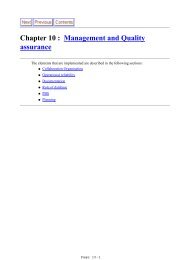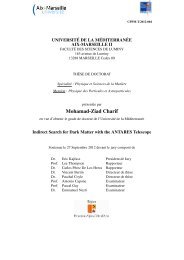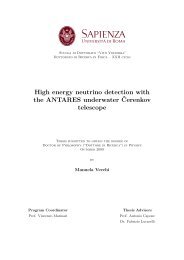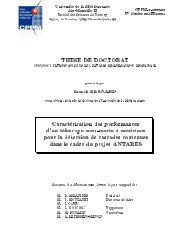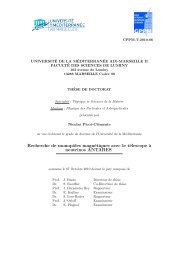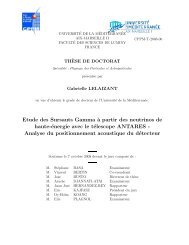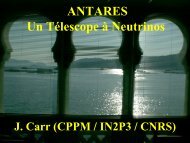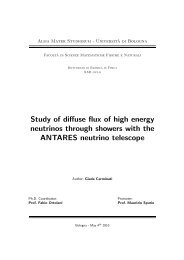Autocorrelation analysis of ANTARES data 1 Introduction
Autocorrelation analysis of ANTARES data 1 Introduction
Autocorrelation analysis of ANTARES data 1 Introduction
You also want an ePaper? Increase the reach of your titles
YUMPU automatically turns print PDFs into web optimized ePapers that Google loves.
F. SCHÜSSLER et al. <strong>ANTARES</strong> AUTOCORRELATION<br />
cumulative events<br />
6<br />
10<br />
5<br />
10<br />
10 4<br />
10<br />
3<br />
10 2<br />
<strong>data</strong><br />
total MC<br />
m MC<br />
n MC<br />
events<br />
5<br />
10<br />
10 4<br />
3<br />
10<br />
10 2<br />
<strong>data</strong><br />
total MC<br />
m MC<br />
n MC<br />
10<br />
10<br />
1<br />
1<br />
-7 -6.5 -6 -5.5 -5 -4.5 -4 -3.5 -3<br />
reconstruction quality L<br />
10 -1<br />
-1 -0.8 -0.6 -0.4 -0.2 0 0.2 0.4 0.6 0.8 1<br />
cos(zenith angle)<br />
Figure 2: Distribution <strong>of</strong> the quality parameter Λ (left plot) and the cosine <strong>of</strong> the reconstructed zenith angle (right plot)<br />
<strong>of</strong> the selected <strong>data</strong> events (markers) compared to Monte Carlo simulations <strong>of</strong> atmospheric muons (red, dotted line) and<br />
atmospheric neutrinos (blue, dashed line).<br />
40<br />
41<br />
42<br />
43<br />
44<br />
45<br />
46<br />
47<br />
48<br />
49<br />
50<br />
51<br />
52<br />
53<br />
54<br />
55<br />
56<br />
57<br />
58<br />
59<br />
60<br />
61<br />
62<br />
63<br />
64<br />
65<br />
66<br />
67<br />
68<br />
69<br />
70<br />
the expectation from the Cherenkov signal <strong>of</strong> a muon track.<br />
1.3 Astrophysical neutrinos<br />
Two main backgrounds for the search for astrophysical<br />
neutrinos can be identified: downgoing atmospheric<br />
muons which have been mis-reconstructed as upgoing and<br />
atmospheric neutrinos originating in cosmic ray induced<br />
air showers at the opposite side <strong>of</strong> the Earth. Depending<br />
on the requirements <strong>of</strong> the <strong>analysis</strong> both backgrounds can<br />
at least partially be discriminated using various parameters<br />
like the quality <strong>of</strong> the event reconstruction or an estimator<br />
for the deposited energy [2].<br />
In addition, analysing the reconstructed arrival directions<br />
<strong>of</strong> the events allows to search for an excess over the uniform<br />
atmospheric backgrounds. Despite important efforts,<br />
no clear signature for point sources <strong>of</strong> astrophysical neutrinos<br />
has been found so far [3, 4, 5, 6]. Both the distribution<br />
and morphologies <strong>of</strong> sources potentially emitting neutrinos<br />
in the TeV energy range are yet unknown but are possibly<br />
very inhomogeneous with most <strong>of</strong> them being located<br />
in the Galactic disk and spatially extended (e.g. shell type<br />
supernova remnants like RXJ1713 [7]). It seems therefore<br />
interesting to study the intrinsic clustering <strong>of</strong> the arrival directions<br />
<strong>of</strong> neutrinos. Possible <strong>analysis</strong> biases are naturally<br />
avoided as no prior information about the potential sources<br />
is required. Covering a large angular range, i.e. neutrino<br />
emission regions <strong>of</strong> very different sizes, this study complements<br />
the searches for point like sources and, if successful,<br />
would provide hints for underlying, yet unresolved, source<br />
morphologies and source distributions.<br />
2 <strong>Autocorrelation</strong> <strong>analysis</strong> 71<br />
The most commonly used method to detect intrinsic clus- 72<br />
ters within a set <strong>of</strong> N events is the standard 2-point auto- 73<br />
correlation distribution. It is defined as the differential dis- 74<br />
tribution <strong>of</strong> the number <strong>of</strong> observed event pairs N p in the 75<br />
<strong>data</strong> set as a function their mutual angular distance ∆Ω. 76<br />
To suppress statistical fluctuations that would reduce the 77<br />
sensitivity <strong>of</strong> the method, we analyse here the cumulative 78<br />
autocorrelation distribution defined as 79<br />
N p (∆Ω) =<br />
N∑<br />
N∑<br />
i=1 j=i+1<br />
H(∆Ω ij −∆Ω), (1)<br />
whereH is the Heaviside step function. 80<br />
2.1 Data set 81<br />
The analysed <strong>data</strong> set has been recorded by the <strong>ANTARES</strong> 82<br />
neutrino telescope in 2007 and 2008. During this period 83<br />
the detector was in its construction phase and has been 84<br />
operated in various setups ranging from 5 active lines at 85<br />
the beginning <strong>of</strong> 2007 to a fully operational detector <strong>of</strong> 12 86<br />
lines since mid 2008. After applying a run selection re- 87<br />
moving for example periods without precise detector align- 88<br />
ment information, the <strong>data</strong>set corresponds to about 300 89<br />
effective days. Comprising mainly atmospheric muons, 90<br />
about 100 million events were reconstructed with the stan- 91<br />
dard <strong>ANTARES</strong> reconstruction algorithm. Basic selec- 92<br />
tion criteria include a cut on the reconstructed zenith an- 93<br />
gle θ to ensure that only upgoing muon tracks are selected 94<br />
(cos(θ) > 0) and a cut on the angular uncertainty β given 95<br />
by the covariance matrix <strong>of</strong> the final likelihood fit (β < 1 ◦ ). 96<br />
The final selection criteria is a cut on the fit quality parame- 97<br />
terΛ, which is derived from the value <strong>of</strong> the maximal like- 98<br />
lihood itself. Before unblinding the <strong>data</strong>, this cut has been 99<br />
optimized by means <strong>of</strong> MC simulations to yield the best 100<br />
average upper limit on the neutrino flux in the search for 101



